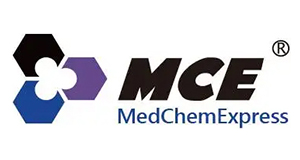DAPT, CAS 208255-80-5
DAPT, CAS 208255-80-5
SKU
MEXHY-13027-10.1
Packaging Unit
10 mM/1 ml
Manufacturer
MedChemExpress
Availability:
loading...
Price is loading...
Product Description: DAPT (GSI-IX) is a potent and orally active γ-secretase inhibitor with IC50s of 115 nM and 200 nM for total amyloid-β (Aβ) and Aβ42, respectively. DAPT inhibits the activation of Notch 1 signaling and induces cell differentiation. DAPT also induces autophagy and apoptosis. DAPT has neuroprotection activity and has the potential for autoimmune and lymphoproliferative diseases, degenerative disease and cancers treatment[1][2].
Applications: Cancer-programmed cell death
Formula: C23H26F2N2O4
References: [1]Dovey HF, et al. Functional gamma-secretase inhibitors reduce beta-amyloid peptide levels in brain. J Neurochem. 2001 Jan;76(1):173-81./[2]Zhou JX, et al. γ-secretase inhibition combined with NSC 119875 enhances apoptosis of nasopharyngeal carcinoma cells.Exp Ther Med. 2012 Feb;3(2):357-361./[3]Li S, et al. DAPT protects brain against cerebral ischemia by down-regulating the expression of Notch 1 and nuclear factor κB in rats. Neurol Sci. 2012 Dec;33(6):1257-64./[4]Tanimizu N, et al. Intrahepatic bile ducts are developed through formation of homogeneous continuous luminal network and its dynamic rearrangement in mice. Hepatology. 2016 Jul;64(1):175-88./[5]Michael T. Chang, et al. Notch Drives Proliferation And Radiation Resistance Of Cancer Stem Cells In Adenoid Cystic Carcinoma. Yale University. January 2016./[6]Majumder S, et al. Shifts in podocyte histone H3K27me3 regulate mouse and human glomerular disease. J Clin Invest. 2018 Jan 2;128(1):483-499./[7]Yixin Tao, et al. β-catenin activation in hair follicle dermal stem cells induces ectopic hair outgrowth and skin fibrosis. J Mol Cell Biol. 2018 May 16.
CAS Number: 208255-80-5
Molecular Weight: 432.46
Compound Purity: 99.97
Research Area: Cancer; Inflammation/Immunology; Neurological Disease
Solubility: DMSO : 62.5 mg/mL (ultrasonic)
Target: Amyloid-β;Apoptosis;Autophagy;Notch;Organoid;γ-secretase
Applications: Cancer-programmed cell death
Formula: C23H26F2N2O4
References: [1]Dovey HF, et al. Functional gamma-secretase inhibitors reduce beta-amyloid peptide levels in brain. J Neurochem. 2001 Jan;76(1):173-81./[2]Zhou JX, et al. γ-secretase inhibition combined with NSC 119875 enhances apoptosis of nasopharyngeal carcinoma cells.Exp Ther Med. 2012 Feb;3(2):357-361./[3]Li S, et al. DAPT protects brain against cerebral ischemia by down-regulating the expression of Notch 1 and nuclear factor κB in rats. Neurol Sci. 2012 Dec;33(6):1257-64./[4]Tanimizu N, et al. Intrahepatic bile ducts are developed through formation of homogeneous continuous luminal network and its dynamic rearrangement in mice. Hepatology. 2016 Jul;64(1):175-88./[5]Michael T. Chang, et al. Notch Drives Proliferation And Radiation Resistance Of Cancer Stem Cells In Adenoid Cystic Carcinoma. Yale University. January 2016./[6]Majumder S, et al. Shifts in podocyte histone H3K27me3 regulate mouse and human glomerular disease. J Clin Invest. 2018 Jan 2;128(1):483-499./[7]Yixin Tao, et al. β-catenin activation in hair follicle dermal stem cells induces ectopic hair outgrowth and skin fibrosis. J Mol Cell Biol. 2018 May 16.
CAS Number: 208255-80-5
Molecular Weight: 432.46
Compound Purity: 99.97
Research Area: Cancer; Inflammation/Immunology; Neurological Disease
Solubility: DMSO : 62.5 mg/mL (ultrasonic)
Target: Amyloid-β;Apoptosis;Autophagy;Notch;Organoid;γ-secretase

 Deutsch
Deutsch










